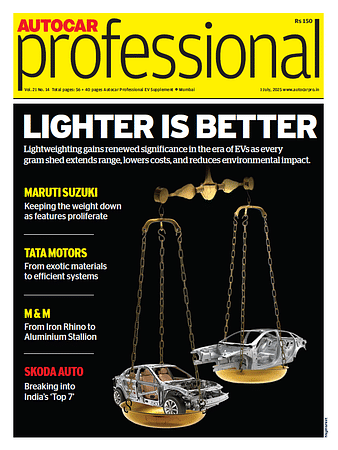‘We have done 22 major engineering changes to the Prima 4038S, primarily for safety and performance.’
Tata Technologies’ Samir Yajnik speaks to Shobha Mathur on what it took to get Tata Prima trucks to go racing at the Buddh Int’l Circuit recently.
Tata Technologies’ Samir Yajnik speaks to Shobha Mathur on what it took to get Tata Prima trucks to go racing at the Buddh Int’l Circuit recently.
How do the Tata Prima racing trucks compare in engineering terms with those racing in the European championships?
Tata Motors’ Prima trucks are competing with each other and have been modified for the truck race in a controlled environment. Their speed has been limited to a maximum of 120kph. We have done 22 major engineering changes to the regular Prima Truck 4038.S model primarily on two heads — safety and performance.
While driving at high speeds and braking, the truck should not overheat and the water cooling system should work effectively in line with the braking system. The Prima racing trucks follow the British truck racing guidelines to make them race-worthy.
The driver has a wide seatbelt configuration so that he is completely constrained and no freedom is allowed to him at high speed. The steering wheel can be removed and dismantled in case of an emergency to extricate the driver, headlights have been removed as the racing event will take place during the daytime. The size of the fuel tank has been reduced to lightweight the truck as it is not plying on the highway or on the roads. The fuel tank has been downsized from 400 litres to a 60-90 litre configuration.
Other modifications have been made in the centre of gravity movement and performance, and for protection at the rear in case of a collision.
Drivers participating in European championships have many years of racing experience so we have incorporated the learnings from them. Those championships have different configured trucks while the Prima race truck is in only one configuration, though it has the capability of going up to a higher speed but since this is the first time it has been controlled.
Which are the new technologies leveraged for the Prima racing truck?
A lot of these new technologies have been system integrated by Tata Motors with the involvement of Tata Technologies engineers. The engine has been optimised by Cummins, the braking system is from Wabco, for the body and external panels Japanese technology has been sourced. Overall, it is the World Truck as it incorporates different components and parts from across the world.
When did work on the Prima racing truck start and how many engineers worked on the program?
The design and engineering process started three years ago at Jamshedpur. The entire integration team of Tata Technologies worked out of Jamshedpur. The entire truck development used 2-3 different CAD systems, along with simulations and analysis with team centre enterprise PLM environment.
The engineers in the engine team worked out of Pune. There were different centres of competencies with about 300 engineers contributing. Most of the testing including digital testing was done at Jamshedpur. Real-life racing conditions were simulated and tested with maximum speed conditions, the crash rollover cage was put for racing at Jamshedpur and tested for physical and digital side impact, besides undertaking frontal crash testing.
Under high speed if the truck driver attempts to take a turn and brake, any vehicle can topple over. Under those extreme conditions we need to make sure the driver does not get hurt. A huge safety and reliability element was involved, so the cab windows were removed so that there is no glass to hurt the driver. Instead, a safety netting was put in its place.
Can these Prima trucks participate in global championships?
We firmly hope that one day over time we will be able to match up to world standards.
Does that mean that at the moment they are not up to world standards?
At the moment we have tested them under different testing conditions and standards. The very fact that we have got the British Truck Racing Association guidance is adequate.
In terms of speed maybe next year onwards we will try to move the trucks to much higher speeds, gradually moving up to 140kph. Today as we stand in engineering terms, we can move up to 140kph speeds and beyond but in a controlled environment for these races. Going to higher speeds will require more engineering in braking systems and more safety tests.
Has Tata Technologies contributed its inputs in global racing events?
We got involved in computational fluid dynamic analysis for Formula 1 cars in England. We have also done work in the past with companies participating in the race.
What are the current trends?
Tata Motors as our customer is liasing with FIA regulations and BTRA regulations to ensure that whatever are the emerging trends and requirements of racing norms are incorporated at the outset. We will continue to do that.
RELATED ARTICLES
India: A Bastion Of Stability for Schaeffler
German autoparts maker Schaeffler’s CEO, Klaus Rosenfeld, describes India’s role in the company’s €24-25 billion empire....
'No Question of Us Being Late' - Suzuki India on e-2Wheeler Market
Suzuki Motorcycle India believes its EV entry is timely as the market is now mature enough to grow off genuine demand ra...
'India Can Become a Major Pillar for Us' - Marquardt Group
Björn Twiehaus, CEO of Marquardt Group, and Vishal Narvekar, the company's India GM, share their outlook on the Indian m...





 04 Apr 2014
04 Apr 2014
 9021 Views
9021 Views





 Ketan Thakkar
Ketan Thakkar


 Angitha Suresh
Angitha Suresh

 Darshan Nakhwa
Darshan Nakhwa

